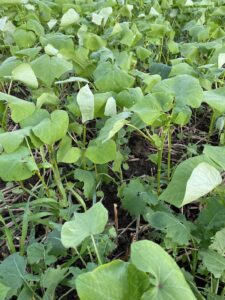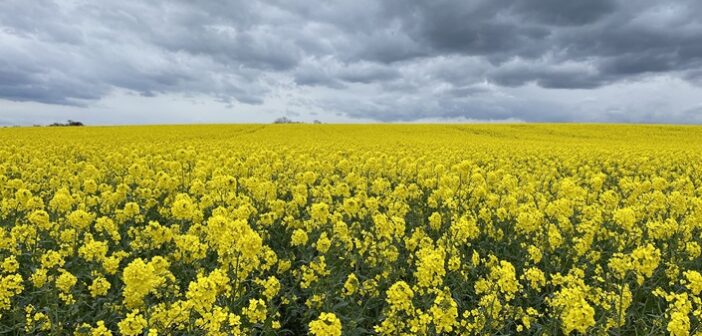With no magic bullet against cabbage stem flea beetle (CSFB), could adjusting drilling date and planting a companion crop put you in a better position?
That is the thought of ProCam regional technical manager, Nigel Scott, who says growers need to think differently about how cabbage stem flea beetle is managed.
CSFB problems can arise whenever winter oilseed rape (WOSR) is planted, he says, but in parts of the country problems appear worse when drilled during its traditional mid to late-August window. This seems to provide a perfect storm for adult beetle invasion and crop failure, he believes.
“If this is the case, depending on individual farm situations, one strategy is to consider planting WOSR much earlier, at the very start of August, or to miss out August completely and plant well into September,” says Mr Scott.
“In both scenarios, varieties need choosing accordingly. Hybrids make sense because you want good establishment from early vigour. But if drilling earlier, you don’t want the crop to get too far ahead over winter, because it will be prone to later frosts.
“Traditionally, varieties have been bred for late-August drilling. So, a changed approach means looking at variety choice in a different way – selecting varieties that sit at either end of the spectrum. These might not be on the Recommended List, but have a specific purpose,” he adds.
Earlier drilling
By drilling earlier, Mr Scott says the aim is to get WOSR to 4-5 leaves before adult beetle migration occurs so it can tolerate adult feeding. Larvae are difficult to avoid in this situation, but if a vigorous plant with a thick stem can be created, he says the crop has a fighting chance.
“I’ve seen crops drilled in the first week of August or into July develop a big collar at the base of the plant. This makes them better able to withstand infestation.
“A variety we’ve seen that’s particularly suited to early drilling is LG Areti. It grows away well initially but has a prostrate growth habit close to the soil over winter. So it’s potentially less at risk from frosts while also providing good ground cover.
“Most critical in terms of CSFB is its spring vigour. It’s very quick to move in spring, meaning it can grow away from larval feeding nice and rapidly.
Later drilling
Alternatively, by planting later, for example well into September depending on location and conditions, Mr Scott says the aim is to plant after adult CSFB migration has finished.
“In September, there should also hopefully be better soil moisture to help establishment and soils should be reasonably warm. However, at this stage, you want a rapidly-establishing plant to compensate for later drilling. Growers need to select the most vigorous variety they can.”
Mr Scott’s recommendation here is RGT Blackmoon. “Its vigour in trials has been outstanding, and field performance is equally impressive. I’ve seen RGT Blackmoon drilled in mid-September race away. Drilled alongside an alternative hybrid, it was chalk and cheese, and the vigour was ultimately the difference between survival and failure. Drilling in September is a useful tool for avoiding beetle, but variety choice is essential.”
Companion cropping
In tandem with drilling date and variety, Mr Scott has had good results with companion cropping to reduce CSFB damage when drilled into stubble.
“A companion crop is a no-brainer for SFI payments anyway. But companion species choice and variety choice are critical if we’re to use them to support our CSFB strategy as well as access the £55/ha payment.
 “New for this year, we’re marketing GreenPack Bronze. This companion crop mix contains tartaric buckwheat, which is a ‘must have’ to help shield WOSR from beetles. But it also contains fenugreek, which has a garlic odour to act as a CSFB deterrent.”
“New for this year, we’re marketing GreenPack Bronze. This companion crop mix contains tartaric buckwheat, which is a ‘must have’ to help shield WOSR from beetles. But it also contains fenugreek, which has a garlic odour to act as a CSFB deterrent.”
Mr Scott says tartaric buckwheat has been selected as a particularly vigorous variety, with a seed size that means GreenPack Bronze can be mixed with the OSR and established together.
“Alternatively it can be established ahead, with the OSR drilled into the protective canopy. Flexibility is key, and the vigour of the companion crop means it is able to provide an IPM tool in either instance as the buckwheat grows ahead of the rape to provide a shield.
“Clearly, companion crops and OSR need moisture irrespective of drilling date, so a stacked approach is needed. Moisture, companions, variety choice and drilling date all need to work together to maximise the chance of success.”
Steps to consider to mitigate CSFB risk
Plant early or late – to avoid peak adult beetle migration
Choose a variety that aligns to your planned drilling date – drilling early requires spring vigour, drilling late demands autumn vigour
Plant a dual-purpose companion crop – providing a shield and deterrent against CSFB
Plant when adequate soil moisture for rapid OSR and companion crop establishment




